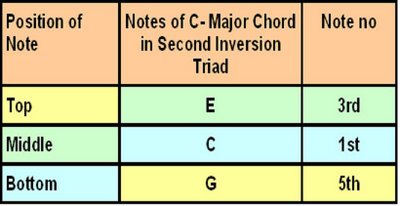In simple terms, Chord Inversion is nothing but shifting the order of the appearance of notes of chords…..!
As Simple as that…!
For example, consider the C-Major chord which is written as C-E-G….!
So the notes on the stave also written in that order from the bottom … so that the note C is at the bottom…then the note E is kept above C…… and finally the note G is kept above E….!

So the interval between C and E is Major 3rd …..! And the interval between C and G is a Perfect 5th …..!
Now, consider the situation, in which the note E, which is the 3rd is kept at the bottom most and C & G are written above E.
So now it is placed as E-C-G……!

Even though, we are still using the notes of C-Major chord, its appearance on a stave as well as its tonal quality is somewhat different from the normal C-E-G chord……!
Its basically because the inversion of interval C to E has taken place and resulted in an interval of E to C….! What we had earlier as Major 3rd between 1st and 3rd is now transformed into Minor 6th …..! So the chord is now said to be inverted…!
Thus, when the 3rd of a chord is put on the bottom most level it is called the First Inversion…!
Next variation is……imagine you put the 5th note, G in this case…., at the bottom most and keep the C and E above this note G….!
Thus what was earlier as Perfect 5th from C to G has now transformed into Perfect 4th between G to C…..!
So again the chord is inverted, but in different fashion…!

Such inversion formed by keeping the 5th at the bottom most is called the Second Inversion……!
You can appreciate the fact that whatever the way the notes are arranged in a stave, the notes played are of the same chord….viz.. C Major chord….!
You place the notes in whatever fashion, C-E-G, C-G-E, E-C-G, E-G-C, G-C-E and G-E-C etc.. all are termed as C-Major Chord only….!

The picture above will clear the inversion concept, I believe !

No comments:
Post a Comment